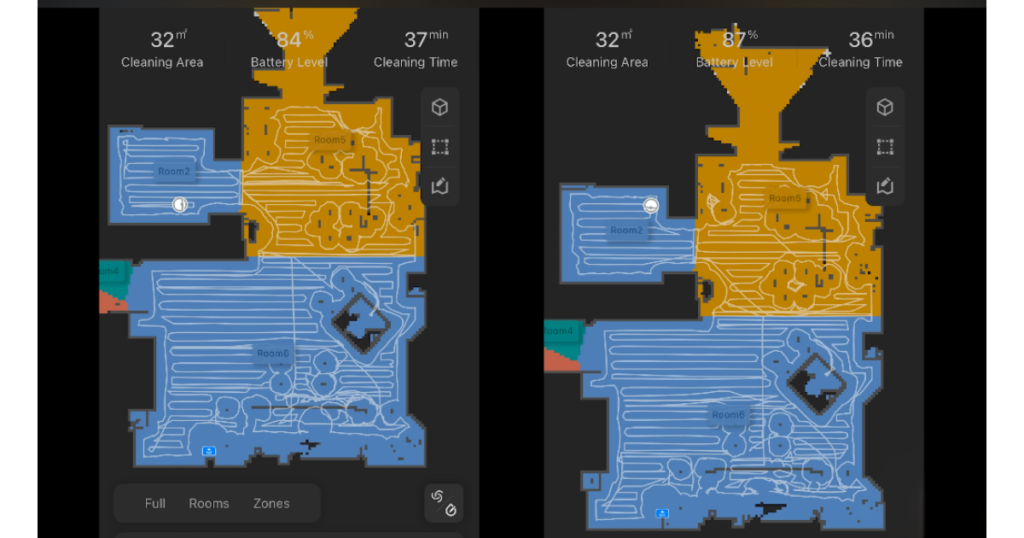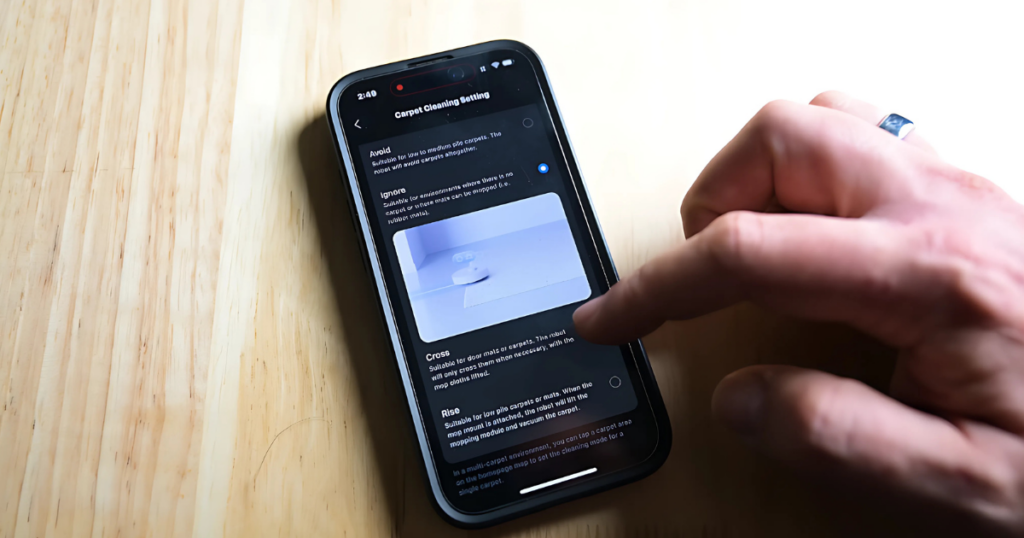Robot vacuum cleaners have become increasingly popular smart-home devices, but their connectivity and sensors also introduce security concerns. Modern robot vacuums map our homes with lasers or cameras and connect to cloud services, which raises issues around data privacy, hacking vulnerabilities, and even physical safety. This report analyzes major security issues reported in the last 3–5 years and examines how leading manufacturers (iRobot, Roborock, Ecovacs, Eufy, etc.) are addressing these concerns through encryption, security protocols, and third-party certifications. Both consumer-friendly explanations and deeper technical insights are provided, followed by an assessment of whether robot vacuums can be considered safe and what consumers should look for when buying one.
Privacy Risks: What Data Your Vacuum Collects and Who Sees It
Modern robot vacuums use sensors (like LIDAR laser scanners and sometimes cameras) to map their environment, raising new privacy questions (Gathering dust and data: How robotic vacuums can spy on you). The data they gather—home layouts, images, and even Wi‑Fi details—could be sensitive if mishandled.
Home Mapping and Personal Data
Robot vacuums today collect detailed information about your home. For example, many models build a floor map of your house (dimensions of rooms, furniture layout, etc.) to navigate efficiently. Some high‑end models (like iRobot’s Roomba j7 series or Roborock’s AI‑enabled vacuums) also have onboard cameras to recognize obstacles (e.g. cables, pet waste) (Why Robot Vacuums Have Cameras (and What to Know About Them)). These cameras can incidentally capture images of household members. In addition, vacuums log usage patterns (when and how often you clean) and technical data like device identifiers, Wi‑Fi network names and signal strength (iRobot Roombas | Privacy & security guide | Mozilla Foundation). All this information, if uploaded to the cloud, forms a digital portrait of your home life. The concern is that such intimate data could be accessed by unauthorized parties or used in ways the owner didn’t expect.

Incidents of Data Leaks
A high‑profile case in late 2022 underscored these privacy risks. An MIT Technology Review investigation revealed that development versions of Roomba vacuums had taken internal test photos — including a private image of a woman on the toilet — which later ended up on social media (Gathering dust and data: How robotic vacuums can spy on you – Why Robot Vacuums Have Cameras (and What to Know About Them)). iRobot explained that these units were given to paid beta testers who consented to being recorded, and that the images were used internally to train AI object recognition. However, the photos were uploaded to a data annotation platform, and some contractors leaked the images in private Facebook groups. This incident, albeit involving non‑commercial test units, showed how visual data collected by vacuums can slip out of control, alarming consumers.
Data Use by Companies
Manufacturers insist that customer data is protected and used responsibly. iRobot, for instance, states that 95% of images used to train its AI come from volunteer contributors or employees in controlled settings (Why Robot Vacuums Have Cameras (and What to Know About Them)), and that production Roombas do not send photos or video without user permission. The company has pledged not to sell customer personal information or maps and to keep robot‑collected data separate from customer account details to de‑identify it (iRobot Roombas | Privacy & security guide | Mozilla Foundation). On the other hand, some budget brands have been less transparent. Eufy, known for touting local storage and privacy, was caught in controversy in 2022: despite marketing its security cameras as never sending data to the cloud, researchers found Eufy was uploading footage to cloud servers without encryption (Eufy Home Security Cameras Caught Uploading Footage to the Cloud). Eufy’s privacy policy also indicates it shares some personal identifiers with advertising partners (Eufy RoboVacs | Privacy & security guide | Mozilla Foundation). Such revelations remind consumers that privacy promises don’t always hold up, making it important to scrutinize how a vacuum’s smart features handle your data.
Cloud Connectivity and Third Parties
When you use a Wi‑Fi connected vacuum via a smartphone app, your data often travels through the manufacturer’s cloud servers. This means the company (and any contractors or partners) might process your info. For example, your floor plan might be stored on cloud servers to sync between your phone and the robot. Amazon’s 2022 announcement to acquire iRobot sparked concern that detailed home maps could become another data source for targeted advertising or smart home strategies (Gathering dust and data: How robotic vacuums can spy on you).

Regulators in Europe even opened an inquiry to ensure that Amazon could not unfairly leverage Roomba data for e‑commerce advantage. The bottom line is privacy risk grows when your home data is shared beyond the device – whether to cloud services or third‑party integrations. Consumers should favor companies with strict data handling policies, minimal data collection, and clear opt‑outs for data sharing, and review the vacuum’s privacy settings.
Hacking Vulnerabilities: How Attackers Could Abuse a Robot Vacuum
Remote Takeover and Spying
Research has shown that some models have serious security flaws that could allow unauthorized control. In 2024, security researchers presented findings on Ecovacs Deebot vacuums at DEF CON, revealing a chain of vulnerabilities that let them take over Ecovacs robot vacuums and even its lawncare robots (Hackers can take over Ecovacs home robots to spy on their owners). They could access the vacuum’s camera and microphone without any indicator light (Hackers can take over Ecovacs home robots to spy on their owners). One flaw allowed anyone within Bluetooth range (up to approximately 450 feet) to connect during a brief window and inject commands to gain full control, potentially allowing access to the home Wi‑Fi, extraction of saved maps, and activation of the camera/mic to silently spy in real time.
“LidarPhone” and Unintended Sensors
Even vacuums without microphones can be co‑opted to spy. In a 2020 academic proof‑of‑concept, researchers demonstrated they could turn a robot vacuum’s LIDAR sensor into an eavesdropping device (Robot Vacuums Suck Up Sensitive Audio in ‘LidarPhone’ Hack | Threatpost). Dubbed “LidarPhone,” the hack involved modifying the vacuum’s firmware to record the minute laser signal changes caused by sound vibrations, which could then be analyzed to reconstruct snippets of speech or identify TV shows, effectively using the vacuum as a remote listening device. Note that this hack required breaching the vacuum and being on the same network.

Network Entry Point
A hacked vacuum can serve as a foothold into your home network. In a 2018 case, researchers discovered that a Chinese‑made vacuum had a default admin password (admin:888888) and an open debug interface, allowing full remote control including access to its camera and movement (IoT Robot Vacuum Vulnerabilities Let Hackers Spy on Victims | Threatpost). In another demonstration, attackers installed a network sniffer via the vacuum’s firmware update mechanism, intercepting unencrypted data from the home network. This vulnerability could be exploited to launch attacks (such as DDoS or crypto‑mining) or steal data.
Manufacturer Responses to Threats
Responsible companies respond to these vulnerabilities with patches. In the Ecovacs case, public exposure of the issues led the company to announce it would patch the flaws within weeks (Hackers can take over Ecovacs home robots to spy on their owners). Companies like iRobot and Roborock employ bug bounty programs and regular security audits to detect and fix vulnerabilities before they can be exploited.
Battery Fire Risks
Robot vacuums use rechargeable lithium‑ion batteries, which, on rare occasions, can overheat or malfunction. In January 2024, a family in Florida experienced a terrifying incident when their vacuum exploded into flames and set the living room on fire, allegedly due to a battery failure (one airlifted to hospital after robotic vacuum cleaner catches fire inside Miami Gardens home). Although such incidents are extremely rare, they highlight the importance of following manufacturer guidelines, using the provided charging equipment, and placing the charging dock in a safe, open area.
Child and Pet Safety
Robot vacuums are generally safe around children and pets. Their slow movement and bump sensors minimize injury risk, though there have been occasional minor incidents. Some models feature a child lock to prevent accidental activation, and overall, the exposed moving parts are low‑torque. Common‑sense precautions, such as keeping hair or fingers away from brushes and supervising young children, further reduce any risk.

Privacy as a Safety Factor
In today’s context, “safety” also means feeling secure about your privacy. A vacuum that transmits data externally can raise concerns about personal security. For those uneasy about a camera mapping your home, choosing models that work fully offline—or ones that allow disabling remote access—can enhance your peace of mind.
How Manufacturers Are Addressing Security
Data Encryption and Secure Communication
Most connected robot vacuums use end‑to‑end encryption for data transmission. For instance, iRobot states that all its connected Roombas use AES‑256 bit encryption over TLS 1.2 (Robot & Data Security at iRobot) and that data at rest on their cloud servers is also encrypted. Similarly, brands like Shark and Samsung employ encryption and secure protocols to protect user data.
Authentication and Access Controls
Ensuring that only authorized users can control the device is a key focus. Vacuums now often require app account sign‑in, email or 2‑factor authentication, and even short Bluetooth pairing windows with physical confirmation. Some devices also feature physical indicators (like a camera LED) to show when sensitive components are active.
Regular Updates and Vulnerability Management
Leading brands treat their robot vacuums like software products, regularly issuing firmware updates that include security fixes. Bug bounty programs encourage researchers to report vulnerabilities, ensuring that manufacturers can patch issues before they are widely exploited.
Third-Party Security Certifications: Do They Ensure Safety?
ETSI EN 303 645 Compliance
A common benchmark for IoT security is the ETSI EN 303 645 standard, a European guideline that outlines 13 best practice areas, including no universal default passwords and secure storage of sensitive data. TÜV Rheinland has certified robot vacuums from brands like Roborock and Xiaomi against this standard (TÜV Rheinland Issues ETSI EN 303 645 Certificate to Mi Robot Vacuum-Mop 2).
TÜV SÜD Cyber Security Certification (CSC)
iRobot’s Roomba j7 series became the first robot vacuum to achieve TÜV SÜD’s Cyber Security Certified mark in 2021. This certification involved extensive penetration testing and an audit of iRobot’s security processes (TÜV SÜD Cyber Security Certification), demonstrating a commitment to ongoing security.
Other Certifications and Standards
Besides ETSI and TÜV, other certifications like the ioXt Alliance pledge and Matter certification also play roles in ensuring robust security measures in IoT devices. These certifications, along with compliance with data protection laws like GDPR and California’s IoT Security Law, indicate that manufacturers are adopting multiple layers of security.
Do Certifications Ensure Security?
While certifications help enforce a baseline of security and demonstrate that a product meets industry standards, they are not a foolproof guarantee against all vulnerabilities. They serve as trust indicators, ensuring that manufacturers have followed known best practices, but ongoing updates and vigilance are essential for maintaining security over time.
Conclusion: Are Robot Vacuums Safe to Use?
For the average consumer, robot vacuums are generally safe – with some caveats. Reputable brands have significantly improved security through encryption, regular updates, and independent audits. Incidents like the Roomba test‑photo leak or the Ecovacs hack have led to industry‑wide improvements, making modern models substantially more secure out‑of‑the‑box.
That said, “safe” doesn’t mean “zero risk.” Consumers should do their homework on a model’s privacy and security features. Look for clear data practices, two‑factor authentication options, and security certifications or positive reviews regarding security. Consider your personal comfort level: if a camera mapping your home is unsettling, opt for models without imaging or with offline functionality.
For those choosing connected models, best practices include:
- Use a strong, unique password for your vacuum’s app account and enable two‑factor authentication if available.
- Keep the firmware and app updated to ensure security patches are applied.
- Review app permission settings and limit access to only what’s necessary.
- Consider segregating IoT devices on a guest network or VLAN to protect your main network.
In conclusion, robot vacuums can be considered safe for most users when purchased from reputable brands and maintained with good security practices. Stay informed and configure your device wisely to enjoy the convenience of automated cleaning without compromising your privacy or safety.
Frequently Asked Questions
Can robot vacuums spy on you through their cameras or sensors?
Answer: Some robot vacuums use onboard cameras and LIDAR sensors to navigate and detect obstacles. While these technologies improve cleaning efficiency, they can raise privacy concerns if misused. In rare cases, images or data from robot vacuums have been leaked or accessed without authorization. Choosing a vacuum from a reputable brand with strict data privacy controls can help reduce this risk.
What kind of personal data do robot vacuums collect?
Answer: Robot vacuums may collect home maps, cleaning habits, Wi-Fi network information, and in some cases, images from onboard cameras. This data is often used to optimize cleaning or sync with smartphone apps. However, if stored in the cloud, it may be accessible to the manufacturer and, potentially, third parties. Always check the brand’s privacy policy and data-sharing practices before purchasing.
Are robot vacuums vulnerable to hacking?
Answer: Like many IoT devices, robot vacuums can have security vulnerabilities. Researchers have demonstrated that certain models could be hacked to access cameras, microphones, or even home Wi-Fi credentials. Look for vacuums with encrypted data transmission, two-factor authentication, and regular firmware updates to minimize these risks.
How can I make my robot vacuum more secure?
Answer: To improve robot vacuum security, use a strong, unique password for the companion app, enable two-factor authentication if available, and regularly update the vacuum’s firmware. Consider using a separate Wi-Fi network for smart devices to isolate them from sensitive home data. Also, review and limit app permissions to only what’s necessary.
Do security certifications like TÜV or ETSI EN 303 645 guarantee privacy?
Answer: Security certifications such as TÜV Cyber Security Certified or ETSI EN 303 645 compliance indicate that a manufacturer has followed recognized best practices, including data encryption and secure user authentication. While certifications are not a foolproof guarantee against all threats, they are strong trust signals that a brand is taking privacy and cybersecurity seriously.




